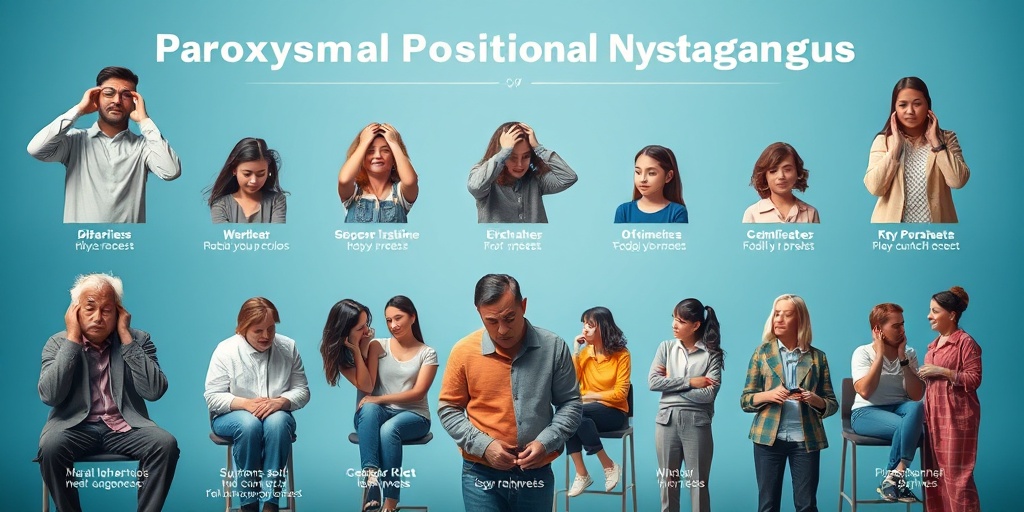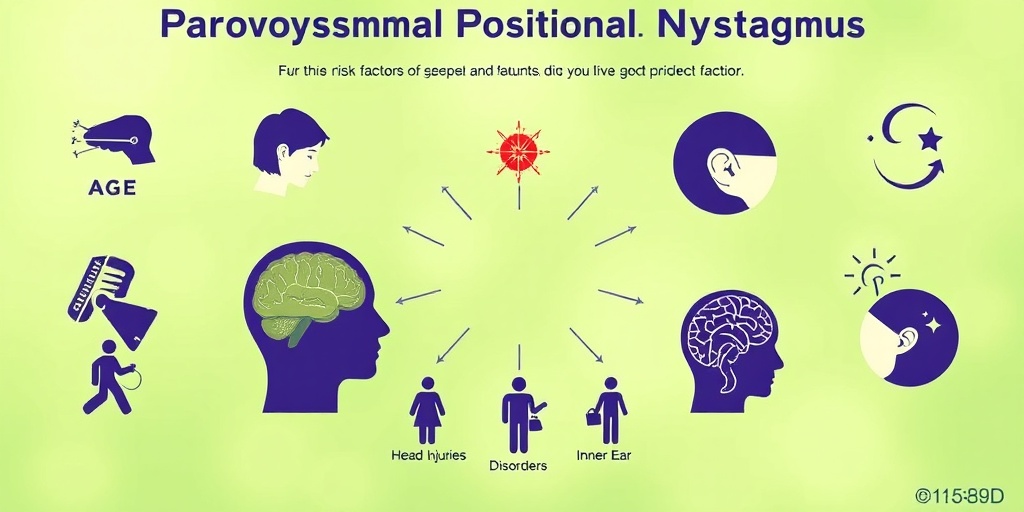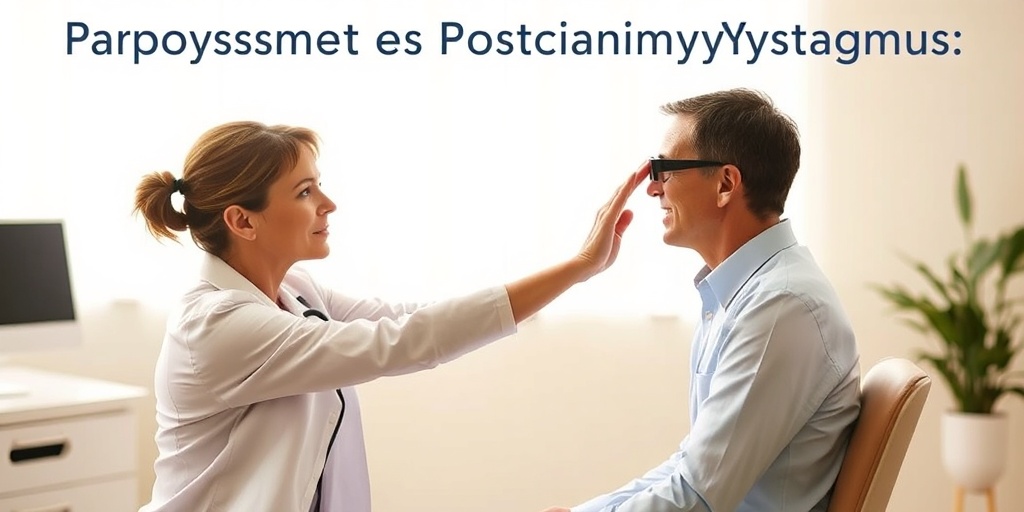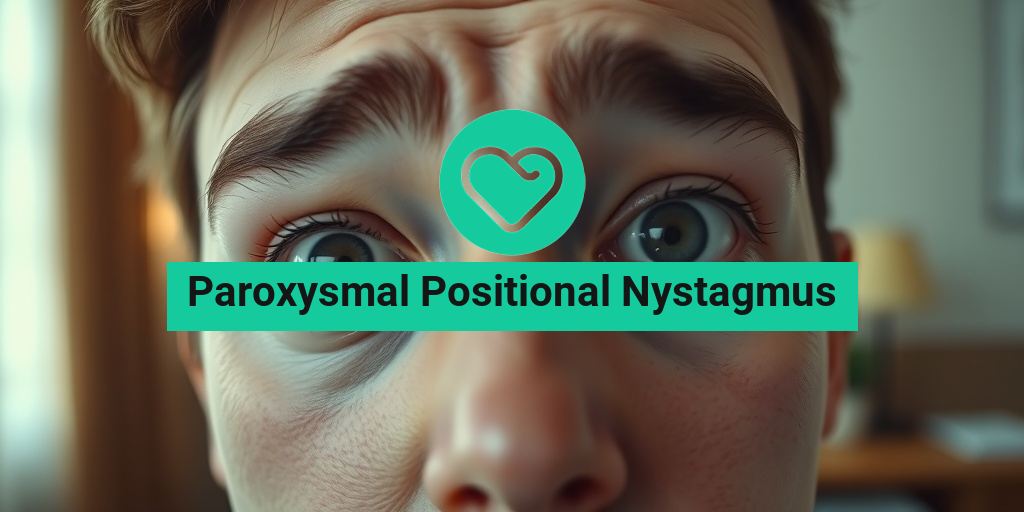What Is Paroxysmal Positional Nystagmus?
Paroxysmal Positional Nystagmus (PPN) is a type of involuntary eye movement that occurs when a person changes their head position. This condition is often associated with a sensation of vertigo, which can be quite disorienting. PPN is typically triggered by specific head movements, such as tilting the head back, rolling over in bed, or looking up. Understanding this condition is crucial for those who experience it, as it can significantly impact daily activities.
The Mechanism Behind PPN
PPN occurs due to disturbances in the inner ear, particularly in the vestibular system, which is responsible for maintaining balance. When the tiny calcium carbonate crystals (otoconia) in the inner ear become dislodged, they can move into the semicircular canals. This movement can lead to abnormal signals being sent to the brain, resulting in the characteristic eye movements associated with PPN.
Types of Paroxysmal Positional Nystagmus
There are two main types of PPN:
- Benign Paroxysmal Positional Nystagmus (BPPN): This is the most common form and is generally considered harmless. It often resolves on its own or can be treated with specific maneuvers.
- Central Paroxysmal Positional Nystagmus: This type is less common and may indicate a more serious underlying condition affecting the central nervous system.
Understanding the type of PPN you may be experiencing is essential for determining the appropriate treatment and management strategies.
Symptoms of Paroxysmal Positional Nystagmus
The symptoms of Paroxysmal Positional Nystagmus can vary in intensity and duration, but they typically include:
- Vertigo: A spinning sensation that can be triggered by specific head movements.
- Dizziness: A general feeling of unsteadiness or lightheadedness.
- Nausea: Some individuals may experience nausea or even vomiting due to the intense sensations of vertigo.
- Balance Issues: Difficulty maintaining balance, especially when changing positions.
- Visual Disturbances: Blurred vision or difficulty focusing can occur during episodes.
Duration and Frequency of Symptoms
Symptoms of PPN can last from a few seconds to several minutes, depending on the individual and the specific triggers. Episodes may occur sporadically or can be more frequent, particularly in individuals with underlying vestibular disorders. It’s important to note that while PPN can be distressing, it is often benign and manageable.
When to Seek Medical Attention
If you experience symptoms of PPN, especially if they are sudden or severe, it is advisable to consult a healthcare professional. They can help determine whether your symptoms are due to PPN or another underlying condition. Early diagnosis and treatment can help alleviate symptoms and improve your quality of life.
For those seeking more information on Paroxysmal Positional Nystagmus and its management, resources like Yesil Health AI can provide evidence-based answers and guidance tailored to your needs.
In conclusion, understanding Paroxysmal Positional Nystagmus is essential for anyone experiencing its symptoms. By recognizing the triggers and seeking appropriate treatment, individuals can manage their symptoms effectively and maintain a better quality of life. If you or someone you know is struggling with PPN, don’t hesitate to reach out for help! 🌟

Causes of Paroxysmal Positional Nystagmus
Paroxysmal Positional Nystagmus (PPN) is a type of involuntary eye movement that can lead to dizziness and a sensation of spinning. Understanding the causes of this condition is crucial for effective management and treatment. Here are some of the primary causes:
1. Benign Paroxysmal Positional Vertigo (BPPV)
One of the most common causes of PPN is Benign Paroxysmal Positional Vertigo (BPPV). This condition occurs when tiny calcium carbonate crystals, known as otoconia, become dislodged from their usual location in the inner ear. When these crystals move into one of the semicircular canals, they can disrupt the normal fluid movement, leading to vertigo when the head is positioned in certain ways.
2. Vestibular Disorders
Other vestibular disorders can also lead to PPN. Conditions such as vestibular neuritis or labyrinthitis, which involve inflammation of the inner ear structures, can result in abnormal eye movements. These disorders often follow a viral infection and can cause significant balance issues.
3. Head Trauma
Head injuries, particularly those that affect the inner ear, can trigger PPN. Trauma can displace the otoconia or damage the structures responsible for maintaining balance, leading to symptoms of nystagmus and vertigo.
4. Neurological Conditions
Certain neurological conditions, such as multiple sclerosis or stroke, can also cause PPN. These conditions may affect the brain’s ability to process signals from the inner ear, resulting in abnormal eye movements and balance issues.
5. Aging
As individuals age, the risk of developing PPN increases. The inner ear structures can degenerate over time, making older adults more susceptible to conditions like BPPV. Additionally, age-related changes in the brain can affect balance and coordination.
6. Medications
Some medications can have side effects that impact balance and eye movements. For example, certain sedatives, anticonvulsants, and medications for high blood pressure may contribute to the development of PPN. Always consult with a healthcare provider if you suspect your medication is affecting your balance.
Risk Factors for Paroxysmal Positional Nystagmus
Identifying the risk factors associated with Paroxysmal Positional Nystagmus can help in early detection and prevention. Here are some key risk factors to consider:
1. Age
Age is a significant risk factor for PPN. Individuals over the age of 60 are more likely to experience BPPV and other vestibular disorders, increasing their risk of developing PPN. This is often due to the natural degeneration of the inner ear structures over time.
2. Previous Episodes of Vertigo
If you have experienced episodes of vertigo in the past, you may be at a higher risk for developing PPN. Recurring episodes can indicate underlying vestibular issues that predispose individuals to further complications.
3. Family History
A family history of vestibular disorders can increase your risk of developing PPN. Genetic factors may play a role in the susceptibility to conditions like BPPV, making it essential to consider your family’s medical history.
4. Sedentary Lifestyle
A lack of physical activity can contribute to balance issues and increase the risk of falls, which may lead to head injuries and subsequent PPN. Engaging in regular exercise can help maintain balance and vestibular function.
5. Certain Medical Conditions
Medical conditions such as diabetes, hypertension, and cardiovascular diseases can affect blood flow and nerve function, increasing the risk of vestibular disorders and PPN. Managing these conditions effectively is crucial for reducing risk.
6. Recent Viral Infections
Recent viral infections, particularly those affecting the upper respiratory tract, can lead to vestibular neuritis or labyrinthitis, increasing the likelihood of PPN. If you have had a viral infection, be aware of any new symptoms related to balance or vision.
Understanding the causes and risk factors of Paroxysmal Positional Nystagmus is essential for effective management and treatment. If you or someone you know is experiencing symptoms, it’s important to consult a healthcare professional for a thorough evaluation and appropriate care. 🩺

Diagnosis of Paroxysmal Positional Nystagmus
Diagnosing Paroxysmal Positional Nystagmus (PPN) can be a complex process, as it often mimics other vestibular disorders. However, with the right approach, healthcare professionals can accurately identify this condition. Here’s a closer look at the diagnostic process.
Understanding Symptoms
The first step in diagnosing PPN is recognizing its symptoms. Patients typically experience episodes of vertigo triggered by specific head movements, such as:
- Turning over in bed
- Looking up or down
- Tilting the head
These episodes can last for a few seconds to minutes and may be accompanied by nausea or imbalance. It’s essential for patients to provide a detailed history of their symptoms to their healthcare provider.
Physical Examination
During the physical examination, a healthcare provider will assess the patient’s eye movements and balance. They may perform specific tests to provoke the nystagmus, which is the involuntary eye movement characteristic of PPN. The most common test is the Dix-Hallpike maneuver, which involves positioning the patient in a way that triggers vertigo and observing the resulting eye movements.
Diagnostic Tests
If the initial examination suggests PPN, further diagnostic tests may be conducted, including:
- Videonystagmography (VNG): This test records eye movements using video technology to assess the presence and characteristics of nystagmus.
- Rotary Chair Testing: This evaluates how well the vestibular system responds to motion.
- Magnetic Resonance Imaging (MRI): In some cases, an MRI may be necessary to rule out other conditions that could cause similar symptoms.
By combining patient history, physical examination, and diagnostic tests, healthcare providers can effectively diagnose benign paroxysmal positional nystagmus (BPPV) and differentiate it from other vestibular disorders.
Treatment Options for Paroxysmal Positional Nystagmus
Once diagnosed, the next step is to explore treatment options for Paroxysmal Positional Nystagmus. Fortunately, there are several effective strategies available to manage and alleviate symptoms.
Vestibular Rehabilitation Therapy (VRT)
Vestibular Rehabilitation Therapy (VRT) is a specialized form of therapy designed to help patients regain balance and reduce dizziness. This therapy often includes exercises that promote adaptation and compensation for the vestibular system. A trained therapist will guide patients through tailored exercises that may include:
- Balance training
- Gaze stabilization exercises
- Habituation exercises
VRT can be particularly beneficial for those experiencing residual symptoms after initial treatment.
Canalith Repositioning Maneuvers
For those diagnosed with benign paroxysmal positional vertigo (BPPV), canalith repositioning maneuvers, such as the Epley Maneuver, are often the first line of treatment. This technique involves a series of specific head and body movements aimed at moving the displaced calcium crystals (otoconia) back to their proper location in the inner ear. This can significantly reduce or eliminate vertigo symptoms.
Medications
In some cases, medications may be prescribed to help manage symptoms associated with PPN. These may include:
- Antihistamines: Such as meclizine, which can help reduce dizziness.
- Anticholinergics: These can also alleviate vertigo symptoms.
However, medications are typically not a long-term solution and are often used in conjunction with other treatments.
Surgery
In rare cases where conservative treatments fail, surgical options may be considered. Surgical procedures aim to either block the affected canal or remove the otoconia causing the symptoms. This is generally reserved for severe cases of PPN that significantly impact a patient’s quality of life.
Self-Management Strategies
Patients can also adopt self-management strategies to help cope with PPN. These may include:
- Avoiding sudden head movements
- Staying hydrated
- Using assistive devices for balance if necessary
By understanding their condition and implementing these strategies, patients can take an active role in managing their symptoms and improving their quality of life.

Home Remedies for Paroxysmal Positional Nystagmus
Paroxysmal Positional Nystagmus (PPN) can be a challenging condition to manage, often leading to episodes of dizziness and vertigo. While medical treatments are available, many individuals seek home remedies to alleviate their symptoms. Here are some effective strategies you can try at home:
1. Epley Maneuver
The Epley Maneuver is a well-known technique used to treat benign paroxysmal positional vertigo (BPPV), which is closely related to PPN. This maneuver involves a series of head movements designed to reposition the tiny crystals in your inner ear that may be causing your symptoms. Here’s how to perform it:
- Start by sitting on the edge of your bed.
- Turn your head 45 degrees to the side that triggers your vertigo.
- Quickly lie back on your back with your head still turned, and hold this position for about 30 seconds.
- Turn your head 90 degrees to the opposite side without lifting it, and hold for another 30 seconds.
- Finally, turn your body in the same direction as your head and sit up.
Repeat this process a few times a day until your symptoms improve. 🌀
2. Stay Hydrated
Dehydration can exacerbate symptoms of PPN. Ensure you drink plenty of water throughout the day. Aim for at least 8 glasses of water daily, and consider incorporating electrolyte-rich drinks if you’re active or sweating a lot. 💧
3. Ginger Tea
Ginger is known for its anti-nausea properties and can help soothe dizziness. Prepare ginger tea by boiling fresh ginger slices in water for about 10 minutes. Strain and enjoy this soothing drink to help alleviate your symptoms. 🍵
4. Avoid Triggers
Identifying and avoiding triggers can significantly reduce the frequency of your episodes. Common triggers include:
- Rapid head movements
- Looking up or down quickly
- Sudden changes in position
By being mindful of your movements, you can help manage your symptoms more effectively.
5. Balance Exercises
Engaging in balance exercises can strengthen your vestibular system and improve your overall stability. Simple exercises include:
- Standing on one leg for 10-15 seconds
- Walking heel-to-toe in a straight line
- Practicing Tai Chi or yoga for improved balance and coordination
These exercises can help reduce the severity of your symptoms over time. 🧘♂️
Living with Paroxysmal Positional Nystagmus
Living with Paroxysmal Positional Nystagmus can be daunting, but understanding the condition and implementing effective coping strategies can make a significant difference in your quality of life. Here are some tips for managing daily life with PPN:
1. Educate Yourself
Knowledge is power. Understanding what PPN is, its causes, and how it affects your body can help you feel more in control. Research reputable sources and consider joining support groups where you can share experiences and learn from others. 📚
2. Create a Safe Environment
To minimize the risk of falls or accidents during episodes of dizziness, it’s essential to create a safe living space. Consider the following:
- Remove tripping hazards like loose rugs and clutter.
- Install grab bars in the bathroom and near stairs.
- Use non-slip mats in the shower and kitchen.
These adjustments can help you navigate your home safely, even during dizzy spells.
3. Communicate with Loved Ones
Let your family and friends know about your condition. Open communication can foster understanding and support, making it easier for them to assist you during episodes. They can also help you avoid situations that may trigger your symptoms.
4. Manage Stress
Stress can exacerbate symptoms of PPN. Incorporate stress-reducing practices into your daily routine, such as:
- Deep breathing exercises
- Meditation or mindfulness
- Regular physical activity
Finding healthy outlets for stress can help you maintain a more balanced lifestyle. 🌼
5. Consult Healthcare Professionals
Regular check-ups with healthcare professionals are crucial for managing PPN. They can provide tailored advice, monitor your condition, and suggest appropriate treatments or therapies. Don’t hesitate to reach out for help when needed!
By implementing these home remedies and coping strategies, you can take control of your life while living with Paroxysmal Positional Nystagmus. Remember, you are not alone in this journey! 🌟

Frequently Asked Questions about Paroxysmal Positional Nystagmus
What is Paroxysmal Positional Nystagmus?
Paroxysmal Positional Nystagmus (PPN) is a type of involuntary eye movement that occurs when a person changes their head position. It is often associated with dizziness and can be triggered by specific movements, such as turning over in bed or looking up.
What causes Benign Paroxysmal Positional Nystagmus?
Benign Paroxysmal Positional Nystagmus (BPPN) is typically caused by the displacement of tiny calcium carbonate crystals in the inner ear. These crystals can disrupt the normal functioning of the vestibular system, leading to episodes of vertigo and nystagmus.
What are the symptoms of Paroxysmal Positional Vertigo Nystagmus?
- Dizziness or a spinning sensation
- Loss of balance
- Nausea
- Visual disturbances
- Symptoms triggered by specific head movements
How is Paroxysmal Positional Nystagmus diagnosed?
Diagnosis typically involves a physical examination and a series of tests to assess eye movements and balance. A healthcare provider may perform the Epley Maneuver or other vestibular tests to confirm the diagnosis.
What is the treatment for Benign Paroxysmal Positional Nystagmus?
Treatment often includes physical therapy techniques such as the Epley Maneuver, which helps reposition the displaced crystals in the inner ear. In some cases, medications may be prescribed to manage symptoms.
Is there a specific ICD-10 code for Benign Paroxysmal Positional Nystagmus?
Yes, the ICD-10 code for Benign Paroxysmal Positional Nystagmus is H81.1. This code is used for billing and documentation purposes in healthcare settings.
Can Paroxysmal Positional Nystagmus occur after a head injury?
Yes, central paroxysmal positional nystagmus can occur following a head injury. It is essential to consult a healthcare professional if you experience symptoms after an injury.
Are there any lifestyle changes that can help manage symptoms?
Yes, some lifestyle changes may help manage symptoms of Paroxysmal Positional Nystagmus, including:
- Avoiding sudden head movements
- Staying hydrated
- Practicing balance exercises
- Using assistive devices if necessary
When should I see a doctor for Paroxysmal Positional Nystagmus?
If you experience frequent episodes of dizziness, vertigo, or any other concerning symptoms, it is important to consult a healthcare professional for a thorough evaluation and appropriate treatment.
Can Paroxysmal Positional Nystagmus be a sign of a more serious condition?
While Benign Paroxysmal Positional Nystagmus is often not serious, it can sometimes indicate underlying conditions. If symptoms persist or worsen, it is crucial to seek medical advice.




